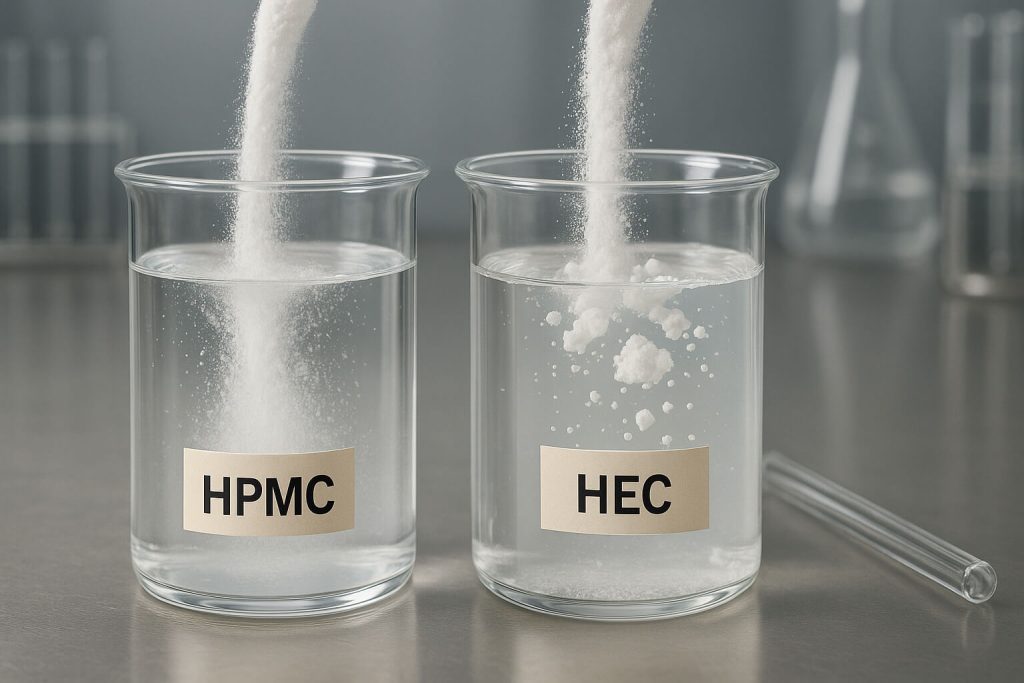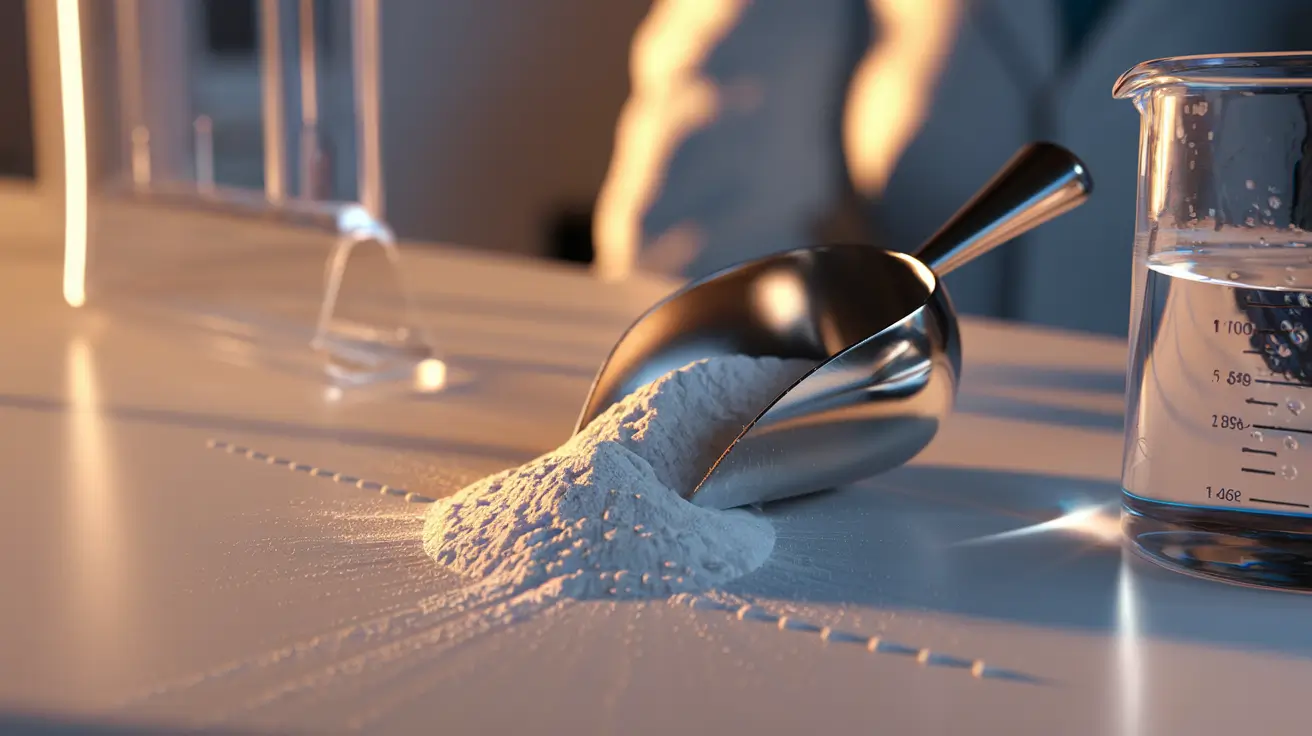In today’s manufacturing and production environments, choosing the right material can make all the difference. Hydroxypropyl Methylcellulose (HPMC) and Hydroxyethyl Cellulose (HEC) are two of the most commonly used cellulose derivatives in various industries, including construction, pharmaceuticals, food, and cosmetics. However, they have distinct properties that set them apart. In this article, we’ll explore the key differences between HPMC and HEC, their uses, and how to choose the right one for your business needs.

1. What is HPMC and HEC?
HPMC and HEC are both cellulose derivatives, but they have different chemical structures and properties. HPMC, also known as Hydroxypropyl Methylcellulose, is derived from natural cellulose and modified with hydroxypropyl and methyl groups. This gives HPMC unique properties, such as water retention and improved viscosity. It is widely used in the construction, pharmaceutical, food, and cosmetic industries.
On the other hand, HEC, or Hydroxyethyl Cellulose, is another water-soluble derivative of cellulose. It’s made by reacting cellulose with ethylene oxide. HEC is highly effective in modifying the rheological properties of liquids, making it a popular choice in paints, coatings, and personal care products.
Here’s the deal: While both materials are cellulose derivatives, they differ significantly in their chemical compositions, applications, and performance characteristics. Understanding these differences can help businesses select the best option based on their specific requirements.
Table: Comparison of HPMC and HEC
| ميزة | شركة HPMC | هيئة التعليم العالي |
|---|---|---|
| Chemical Composition | Hydroxypropyl methyl groups | Hydroxyethyl groups |
| الذوبان | Soluble in cold water | Soluble in water |
| التطبيقات الشائعة | Pharmaceuticals, food, cosmetics, construction | Paints, coatings, personal care products |
| اللزوجة | Higher viscosity in water | اللزوجة المعتدلة |
2. What are the Main Differences Between HPMC and HEC?
HPMC vs. HEC – What sets them apart? Both have their advantages depending on the application. However, the most notable differences between HPMC and HEC are their solubility, viscosity, and water retention properties.
- التركيب الكيميائي: As mentioned, HPMC contains hydroxypropyl and methyl groups, which increase its water retention and create a thicker, more stable solution. HEC, on the other hand, is modified with ethylene oxide, which gives it different solubility and viscosity characteristics.
- اللزوجة: HPMC tends to have a higher viscosity than HEC when dissolved in water, making it ideal for applications where thicker consistency is needed. For instance, in construction materials like tile adhesives and dry mortars, HPMC’s higher viscosity improves the stability and workability of these mixtures.
- احتباس الماء: HPMC’s water retention properties make it a better choice in situations where moisture control is crucial. This is especially useful in pharmaceutical formulations, where consistent moisture levels are required for stability and efficacy.
Here’s why this matters: Selecting the right material depends on your specific application. If you need thicker solutions and higher viscosity, HPMC is likely your go-to. But if moderate viscosity and effective dispersion are required, HEC may be more suitable.
Table: Viscosity and Solubility Comparison
| ملكية | شركة HPMC | هيئة التعليم العالي |
|---|---|---|
| الذوبان | Soluble in cold and hot water | Soluble in water |
| Viscosity (Water Solution) | عالي | معتدل |
| احتباس الماء | عالي | معتدل |
3. How Do HPMC and HEC Affect the Construction Industry?
In the construction industry, both HPMC and HEC are indispensable for improving the performance of various materials. But which one is better for your construction needs? Let’s explore how each one plays a role.
شركة HPMC is widely used in the production of tile adhesives, dry mortars, and cement-based products. Its ability to enhance water retention makes it an ideal choice for these applications. It ensures that materials maintain adequate moisture for longer periods, resulting in better bonding strength and improved workability.
هيئة التعليم العالي, while still useful, is less commonly found in construction materials. However, it can be used in some specific formulations, such as paints and coatings. Its role in improving the flow and leveling properties of paints makes it useful in the decorative and protective coatings sector.
The key takeaway: HPMC’s superior water retention and viscosity properties make it more effective in construction applications, particularly in dry mortar and tile adhesives. It’s the better option when long-lasting moisture control and workability are critical.
Table: HPMC and HEC in Construction Applications
| نوع التطبيق | شركة HPMC | هيئة التعليم العالي |
|---|---|---|
| Tile Adhesive | Excellent water retention | Moderate water retention |
| Dry Mortar | Improves workability | Limited usage |
| الدهانات والطلاءات | Not typically used | Used for flow and leveling |
4. How Do HPMC and HEC Compare in the Pharmaceutical Industry?
Both HPMC and HEC have found their place in the pharmaceutical industry. But which one works better for drug formulation? Let’s break it down.
شركة HPMC is particularly well-suited for controlled-release drug formulations. Its ability to form gels and retain moisture helps create drug delivery systems that release medication slowly over time. This makes it a popular choice in the production of tablets, capsules, and coatings.
هيئة التعليم العالي, on the other hand, is mainly used in oral and topical formulations for its thickening and stabilizing properties. It’s often incorporated into suspensions, gels, and creams, where its main role is to improve consistency and texture.
Here’s the deal: If you’re looking for a cellulose derivative to help with controlled drug release, HPMC is your best option. HEC is more commonly used for improving the texture and stability of topical and oral solutions.
Table: HPMC vs. HEC in Pharmaceuticals
| طلب | شركة HPMC | هيئة التعليم العالي |
|---|---|---|
| Controlled-Release Formulations | Ideal for controlled release | Not commonly used |
| Oral and Topical Solutions | Used for tablet coatings | Used for suspensions, gels |
5. What Are the Key Benefits of Using HPMC in Food Products?
HPMC isn’t just useful in industrial applications; it’s also a valuable food additive. But why should you consider HPMC in food products?
HPMC is commonly used in food processing as a stabilizer, emulsifier, and thickener. Its ability to form gels makes it a great choice for controlling the texture and consistency of various products. In processed foods, it helps extend shelf life and maintain the desired texture.
For instance, HPMC is used in gluten-free foods to provide structure and texture that mimics traditional wheat-based products. It also plays a role in the production of ice cream, where it helps prevent ice crystal formation, resulting in a smoother, creamier texture.
So, what’s the bottom line? HPMC’s versatility in improving texture and stability makes it a critical component in the food industry, especially for products that need to maintain a consistent quality over time.
Table: HPMC Uses in the Food Industry
| Food Product Type | HPMC’s Role |
|---|---|
| الأطعمة الخالية من الغلوتين | Provides structure and texture |
| Ice Cream | Prevents ice crystal formation |
| Sauces and Dressings | Acts as an emulsifier and thickener |
6. How Does HEC Benefit the Cosmetic Industry?
In cosmetics, texture and consistency are key. So, how does HEC contribute to these formulations?
HEC is a valuable ingredient in the cosmetic industry, where it is used to improve the texture and viscosity of various products, including shampoos, lotions, and facial creams. It acts as a stabilizer, ensuring that the formulation remains consistent and smooth during use.
In addition, HEC’s ability to form gels and stabilize emulsions makes it a perfect fit for skincare products like moisturizers and serums. By improving the spreadability and consistency, it enhances the overall user experience.
The key takeaway? HEC is the go-to ingredient when you want to improve the texture and stability of cosmetic formulations without compromising performance.
Table: HEC in Cosmetics
| Cosmetic Product Type | HEC’s Role |
|---|---|
| Shampoos | Improves texture and viscosity |
| Facial Creams | Stabilizes emulsions and gels |
| Lotions | Enhances spreadability |
7. Which One Is More Cost-Effective: HPMC or HEC?
When it comes to selecting materials, cost is always a factor to consider. So, which is more cost-effective – HPMC or HEC?
هيئة التعليم العالي tends to be less expensive than HPMC, making it a more cost-effective option in applications where high viscosity and water retention are not critical. Its lower production cost and versatility make it a popular choice in industries like cosmetics and paints.
However, شركة HPMC tends to justify its higher cost with its superior performance in applications where viscosity, water retention, and controlled release are crucial. Industries such as pharmaceuticals and construction often find the added expense worth the improved performance.
The takeaway? If cost is a major concern, HEC may be the more affordable option for your business. However, if high performance and specialized properties are essential, HPMC may be worth the investment.
Table: Cost Comparison of HPMC and HEC
| Material | Cost Comparison |
|---|---|
| شركة HPMC | أغلى |
| هيئة التعليم العالي | Less expensive |
8. How Are HPMC and HEC Produced?
Understanding the production processes of these materials is key to selecting the right one for your needs. So, how are HPMC and HEC produced?
Both HPMC and HEC are produced through chemical modification of cellulose. For HPMC, the cellulose is reacted with propylene oxide and methyl chloride to introduce hydroxypropyl and methyl groups. This process results in a highly soluble polymer with excellent water retention and thickening properties.
HEC is produced by reacting cellulose with ethylene oxide, which introduces hydroxyethyl groups into the cellulose structure. This modification enhances its solubility in water and gives it its characteristic thickening ability.
In summary: The production of both HPMC and HEC involves modifying natural cellulose to improve its properties. However, the differences in chemical reagents and process steps lead to distinct properties in the final products.
Table: Production Methods for HPMC and HEC
| Material | عملية الإنتاج |
|---|---|
| شركة HPMC | Reaction with propylene oxide and methyl chloride |
| هيئة التعليم العالي | Reaction with ethylene oxide |
9. What Are the Environmental Impacts of HPMC and HEC?
As sustainability becomes a growing concern in manufacturing, understanding the environmental impact of materials is crucial. So, how do HPMC and HEC stack up?
Both HPMC and HEC are derived from cellulose, a renewable resource, making them relatively environmentally friendly. However, the production processes for these materials can have varying environmental impacts depending on the chemical reagents used and the energy required.
HPMC’s production process, which involves methylation and hydroxypropylation, can result in higher energy consumption and chemical waste compared to HEC’s simpler ethylene oxide reaction.
What does this mean for your business? If sustainability is a priority, you’ll need to consider the environmental implications of both materials’ production processes when choosing between HPMC and HEC.
Table: Environmental Impact of HPMC and HEC Production
| Material | Environmental Considerations |
|---|---|
| شركة HPMC | Higher energy consumption and waste |
| هيئة التعليم العالي | Simpler production process |
10. What Are the Future Trends for HPMC and HEC?
As industries evolve, so too do the materials used. What does the future hold for HPMC and HEC?
Looking ahead, we can expect both HPMC and HEC to continue to play important roles in various industries. With ongoing innovations in formulation technologies, both materials will likely be adapted for new applications.
HPMC is expected to see increased use in controlled-release drug formulations and advanced construction materials. Its unique properties make it well-suited to meet the growing demand for sustainable and efficient products.
HEC, while a more cost-effective option, is likely to remain a staple in the cosmetic and personal care sectors. As consumer demand for high-quality, eco-friendly products grows, HEC’s biodegradable properties will become more attractive to manufacturers.
The future of both materials looks promising. As industries continue to innovate, HPMC and HEC will undoubtedly find new applications and improve upon existing ones.
Table: Future Trends for HPMC and HEC
| Material | Expected Trends |
|---|---|
| شركة HPMC | Growth in pharmaceuticals and construction |
| هيئة التعليم العالي | Focus on eco-friendly personal care products |
خاتمة
In conclusion, while HPMC and HEC are both cellulose derivatives, their differences in chemical structure, viscosity, and applications make them suitable for different purposes. HPMC is ideal for industries like construction, pharmaceuticals, and food, while HEC is commonly used in cosmetics and personal care products. Understanding the key differences will help you select the right material for your business needs.
قسم الأسئلة الشائعة
Q1: ما هو HPMC؟
HPMC (Hydroxypropyl Methylcellulose) is a water-soluble cellulose derivative used widely in construction, pharmaceuticals, food, and cosmetics due to its high viscosity and water retention properties.
Q2: How does HPMC work in construction applications?
HPMC improves water retention and workability in construction materials like dry mortar and tile adhesives, helping to achieve better bonding and stability.
Q3: How does HEC compare to HPMC in terms of viscosity?
HEC typically has lower viscosity than HPMC, making it more suitable for applications requiring moderate thickening, such as in paints and coatings.
Q4: Can HPMC be used in food products?
Yes, HPMC is used in food processing as an emulsifier and thickener, providing structure and improving the texture of gluten-free products and ice cream.
Q5: What industries benefit most from HEC?
HEC is mainly used in the cosmetic and personal care industries, where it serves as a thickening agent and stabilizer in lotions, shampoos, and creams.




